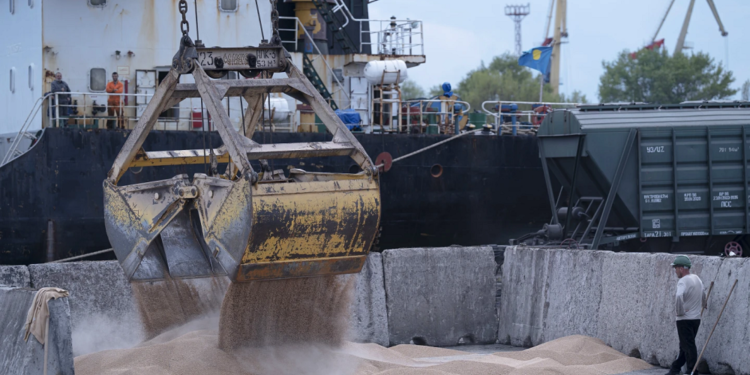LONDON (AP) — Russia has repeatedly fired missiles and drones at Ukrainian ports key to sending grain to the world. Moscow has declared large swaths of the Black Sea dangerous for shipping. Even the U.S. said ships are at risk of being targeted.
There is still interest from ship owners in carrying Ukrainian grain through the Black Sea — if they can mitigate the risk, according to a major shipping group. And that’s a big if.
Despite the warnings and port attacks, which have leveled grain infrastructure, “shipping has always been very, very resilient in the face of these sorts of risks,” said John Stawpert, senior manager of environment and trade for the International Chamber of Shipping, which represents 80% of the world’s commercial fleet.
This week’s strikes came after Russia pulled out of a wartime accord that the U.N. and Turkey brokered last year to provide safeguards for shipping companies in a bid to end a global food crisis. Ukraine — which, along with Russia, is a major supplier of wheat, barley and vegetable oil to developing nations — shipped 32.9 million metric tons of grain to the world and supplied 80% of the World Food Program’s wheat for humanitarian aid so far this year.
Following the grain deal’s collapse, Ukraine sent a letter to the U.N. International Maritime Organization establishing its own temporary shipping corridor, saying it would “provide guarantees of compensation for damage.”
But Russia warned this week that ships traversing parts of the Black Sea would assume to be carrying weapons to Ukraine. In a seeming tit-for-tat move, Ukraine said vessels heading to Russian Black Sea ports would be considered “carrying military cargo with all the associated risks.”
Russian Deputy Foreign Minister Sergei Vershinin said Friday that the navy will check vessels to ensure they are not carrying weapons before taking other action.
Continued shipments from Ukraine will depend on vessels getting insurance for potential damage or injuries and deaths to crew members and how the safety risks play out. Ships that were exporting Ukrainian grain can be worth tens of millions of dollars, have 20 to 22 sailors on board and carry food also worth tens of millions, according to Jayendu Krishna, deputy head of maritime advisers at Drewry, a maritime research consultancy.
All ships go through threat assessments to allow crews to protect against problems before setting sail, which have grown in importance as ships deal with piracy, terrorism and war zones.
ADVERTISEMENT
For the Black Sea, the risks for ships would be: explosive mines, becoming collateral damage at ports or being targeted themselves, which Stawpert said would be “a huge escalation.”
“The million-dollar question is whether the threats to merchant shipping are serious and whether they’ll be followed through. And there’s no firm way of knowing that until it actually happens,” Stawpert said, adding that he has not yet heard from insurers.
With Russia’s warnings, “it is unlikely that underwriters will want to cover that risk,” said the International Union of Marine Insurance, which represents national and international marine insurers.
The group thought it was unlikely owners would put their ships and crews in danger, echoed by Munro Anderson, head of operations for Vessel Protect, which assesses war risks at sea and provides insurance with backing from Lloyd’s, whose members make up the world’s largest insurance marketplace.
He didn’t directly speak to whether underwriting businesses like his would take on the risk but said without protections for ships like they had under the grain deal, “safety conditions cannot be guaranteed.”
Krishna said the only way to mitigate risk was through insurance from the 12 providers making up the International Group of P&I Clubs, which offers liability coverage for about 90% of the world’s cargo shipped by sea, according to its website.
“P&I clubs will be wary of even insuring” without a guarantee from the U.N. or some other body, he said.
The International Group of P&I Clubs said its CEO was the only one who could comment and that he was on vacation. Individual clubs either declined to comment or did not respond to calls or emails.
The head of the seafarers division of the International Transport Workers’ Federation, a union for crew members, said the question should be whether it’s too risky right now to ask sailors to go to Ukrainian ports.
“The minds of seafarers won’t be on questions of insurance cover, but more likely on whether their lives are safe amidst the fighting,” David Heindel said in a statement, adding that crews “should never be targeted just for doing their job.”
In the meantime, some analysts expect most of what Ukraine was going to ship through the Black Sea will get out by road, rail and river through Europe, but the transportation costs will be higher and likely lead to lower production by Ukrainian farmers.
Ukrainian Foreign Minister Dmytro Kuleba said Thursday that Ukraine has made progress in improving those routes but that the best way to export grain is through the Black Sea. That’s how 75% of the country’s grain got to the world before the war, analysts say.
Plus, the routes have created divisions in the European Union, with five countries saying Wednesday that they want to extend a ban on Ukrainian grain imports through the end of the year.
While Poland, Slovakia, Hungary, Romania and Bulgaria would keep allowing grain to move through their borders to world markets, their bans could create challenges like infrastructure backups that might give preference to local grain before Ukraine’s products, said Carlos Mera, head of agricultural commodities markets at Rabobank.
The five countries say Ukrainian grain has flooded their markets, leading to a glut that drove down prices for their farmers and stirring protests. They signed a joint declaration ahead of EU talks next week, urging officials to work out ways of getting Ukrainian food to the world without hurting their agricultural industries.
It’s another hurdle for Ukraine — and possibly for developing countries already struggling with high local food prices, which are helping drive hunger.
Wheat prices have risen about 17% over the last week, and poorer nations that are forced to pay more on world markets for the ingredient for staples like bread and pasta means “many millions of people being pushed into food insecurity,” Mera said.













